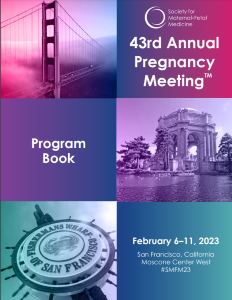Category: Hypertension
Poster Session IV
(940) Blood pressure trajectories through pregnancy and first year postpartum following a hypertensive disorder of pregnancy
Hypertensive disorders of pregnancy (HDP) are associated with increased risk for cardiovascular sequelae due largely to persistent hypertension (HTN). Blood pressure (BP) patterns may provide further risk stratification. We compared pregnancy and postpartum BP trajectories among individuals with a HDP who developed persistent HTN at one year postpartum to individuals with BP normalization.
Study Design:
We utilized data from a randomized clinical trial of overweight and obese individuals with no pre-pregnancy HTN and physician-adjudicated HDP. Pregnancy BPs were obtained during routine prenatal visits. Postpartum BPs were prospectively obtained using home BP monitoring (HBPM) daily for the first six weeks and one week per month for the remainder of the first year postpartum. Demographic characteristics and trajectories were compared by persistent HTN status (systolic BP ≥130, diastolic BP ≥80 mmHg or use of anti-hypertensive medications) at one year after delivery as assessed at a research study visit. We used repeated BP measures to fit mixed-effects linear regression models for pregnancy and postpartum HBPM with participant identifier as random intercepts and weeks as a fixed effect using restricted cubic splines. Models were compared using likelihood ratio tests.
Results:
We included 129 individuals; 993 pregnancy BPs and 14,177 postpartum BPs. In total, 75 individuals (58%) developed HTN by 1 year postpartum. Individuals with persistent HTN were older and delivered at earlier gestational ages. There were no differences in BP at initial prenatal visit or trajectories during pregnancy. Individuals with persistent HTN had a more adverse BP trajectory (p< 0.01 for systolic and diastolic BP) in the first year postpartum. These differences persisted in multivariable models after adjustment for pre-pregnancy BMI and type of HDP.
Conclusion:
BP patterns during pregnancy were unrelated to persistent HTN at one year postpartum among those with HDP. In contrast, BP trajectories in the first year postpartum may provide critical information for risk stratification after a HDP.

Alisse Hauspurg, MD
Assistant Professor
University of Pittsburgh
Pittsburgh, Pennsylvania, United States
Alisse Hauspurg, MD
Assistant Professor
University of Pittsburgh
Pittsburgh, Pennsylvania, United States- RH
Renee Hart, BS
Magee-Womens Research Institute
Pittsburgh, Pennsylvania, United States .jpeg.jpg)
Tiffany Wang, MD
Magee-Womens Hospital, University of Pittsburgh Medical Center
Pittsburgh, Pennsylvania, United States- SB
Samantha Bryan, MPH
Magee-Womens Research Institute
Pittsburgh, Pennsylvania, United States - AJ
Arun Jeyabalan, MD, MSCR
Magee-Womens Hospital, University of Pittsburgh
Pittsburgh, Pennsylvania, United States 
Janet M. Catov, PhD
Associate Professor
Magee-Womens Research Institute
Pittsburgh, Pennsylvania, United States

.png)
